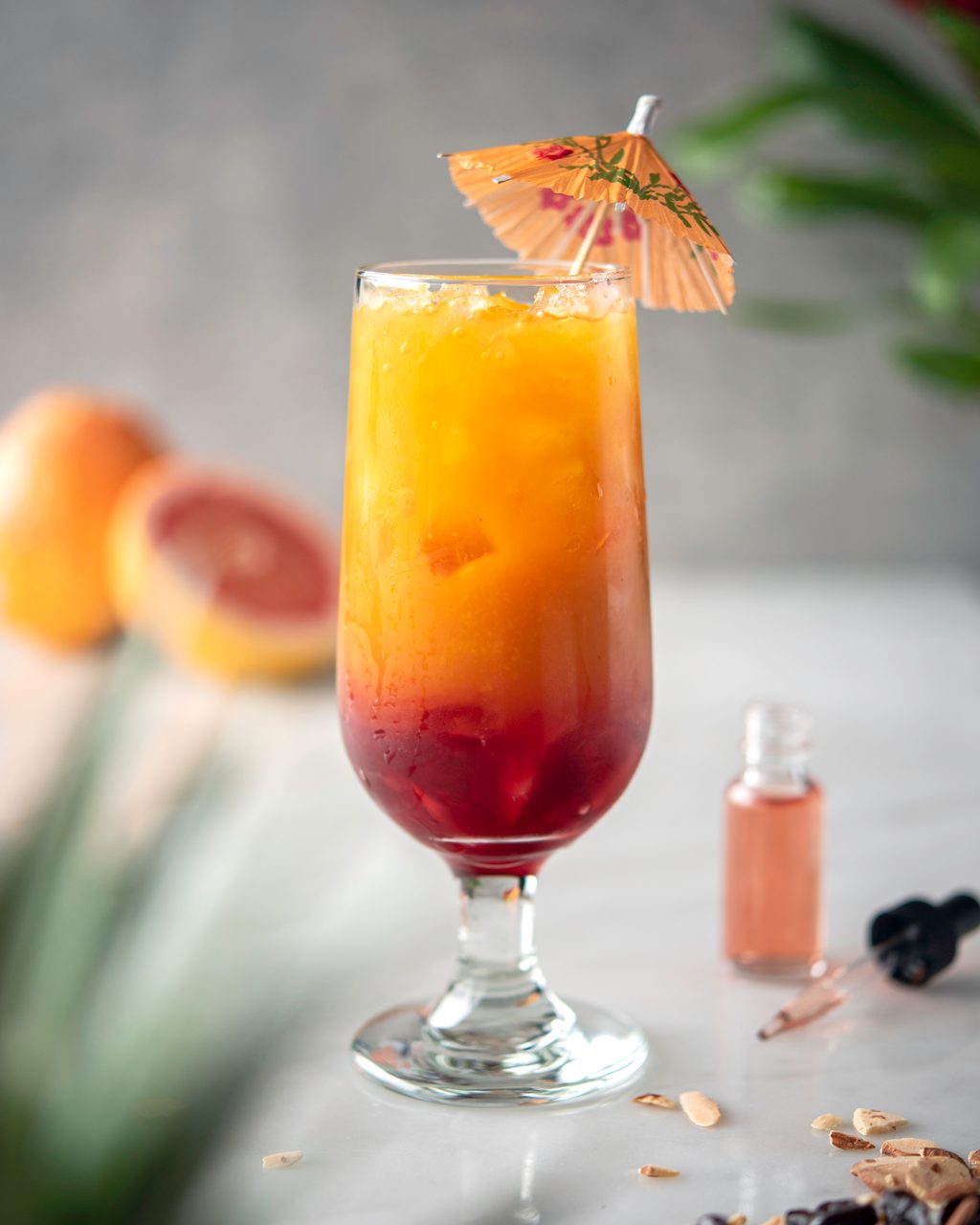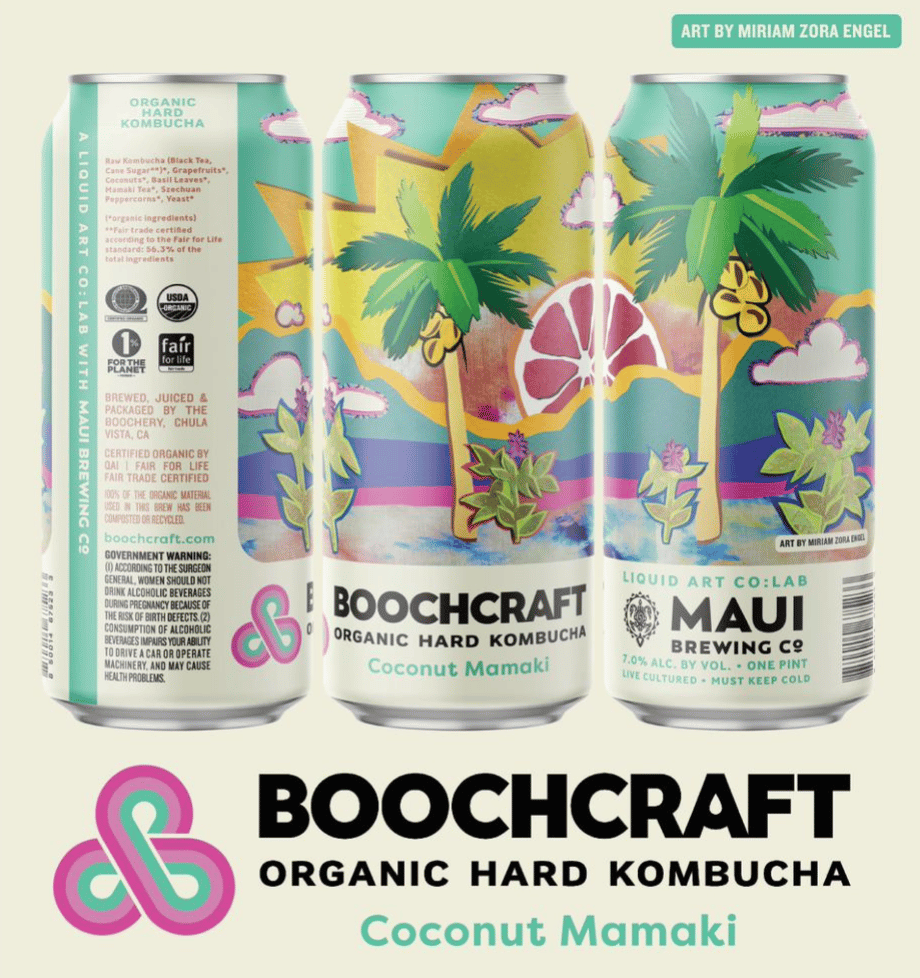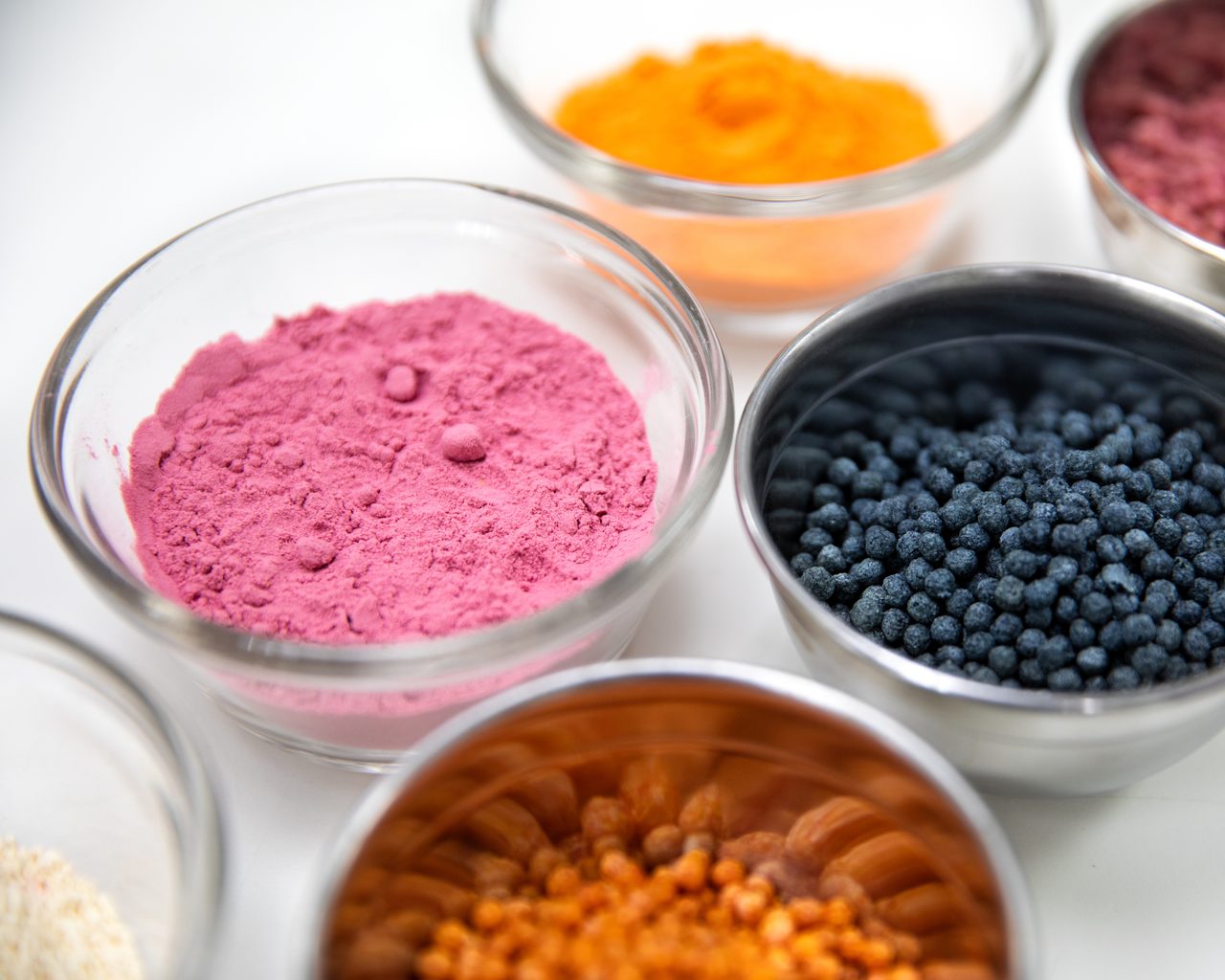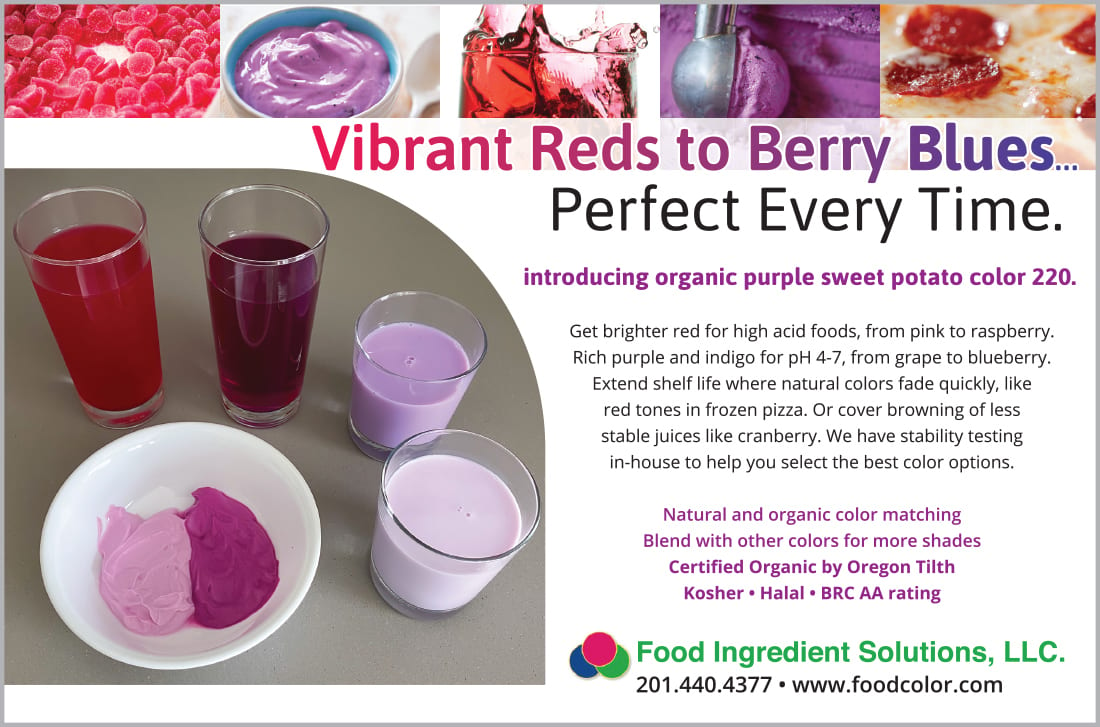Beverage
R&D
Sensient Natural Extracts provide a rainbow of Certified Organic Color offerings, as well as authentic taste solutions from botanicals. Compatible color-flavor-extract blends will enable faster speed-to-market for rapid beverage innovation, Meghan Fox says. (Image courtesy of Sensient Food Colors)
A rainbow of choices
Natural colors shine through in beverage formulations
By Barbara Harfmann
In Cyndi Lauper’s 1986 chart-topping hit “True Colors,” she reminds people to take courage in the world so that others can see “your true colors shining through.” In a world full of new products and the ever-flourishing clean-label revolution, the natural food colors market is “shining through” as ingredient suppliers and consumers alike embrace these solutions.
Emina Goodman, senior director of commercial color development for ADM, emphasizes that today’s consumers are not only interested in ingredients from natural sources, but also are looking for healthier and sustainable options.
Research from the Chicago-based company also points to this fact. Fifty percent of consumers prefer products that contain natural ingredients they consider to be beneficial to their health; 62% of consumers are actively avoiding artificial coloring in their food and beverage purchases; and 69% of consumers say simple, recognizable ingredients influence their purchasing decisions.
“This ongoing clean-label trend is creating a demand for beverage makers to use colors that are sourced from nature in their formulations,” Goodman says. “… With an increasing number of consumers seeking transparency and simplicity in their drinks, we support product developers with the broadest portfolio of on-trend, plant-based and closer-to-nature ingredients that work well for clean and clear labels.”
The color and appealing look of a beverage is key to propelling purchasing behavior as consumers taste with their eyes, experts note. (Image courtesy of GNT)

A Natural Food Color Market report from Dublin-based Fact.MR estimates that the global natural food colors industry will reach $17 billion by 2031, growing at compound annual growth rate (CAGR) of more than 7%, an increase from the 4% CAGR and $8.5 billion that natural food color sales notched between 2016 and 2020.
“The ever increasing healthy eating trends observed throughout the coronavirus pandemic crisis further fueled expansion prospects in the past year alone,” the report said. Anthocyanin remains the top selling natural food color, expanding at a 6% CAGR.
Noting that today’s color options are “almost limitless,” Rene Fonteijn, industry business manager for Oterra, (formerly Chr. Hansen Natural Colors), says the company supports the creativity and innovation of beverage-maker’s color requests. He notes, however, that shades of blue remain difficult to pull off.
“We can achieve a full spectrum of colors by blending different pigments,” he explains. “Blue, however, remains a difficult shade for the beverage industry, as there is no blue pigment available from nature that is stable in an environment with high acidity and low viscosity, which is the case for most beverages.”
The Hørsholm, Denmark-based company suggests that carbonated soft drinks (CSD) are the largest colored segment, while bottled water has the least amount of demand.
Brian Sethness, executive vice president of sales and marketing for Sethness Roquette, Skokie, Ill., concurs. “Caramel color is the world’s most widely used colorant. It is the go to color for the soft drink industry, and it is surprisingly a very important flavoring agent that has helped ’trick’ the mind when it comes to taste.”
Due to the low pH of most carbonated beverages, Sethness Roquette Class IV Caramel Colors are commonly used because of their acid stability. “In addition to providing excellent reddish to brown hues, caramel colors can enhance the foaming characteristics, mouthfeel and flavor of soft drinks,” Sethness says. “There are at least 20 caramel colors that can be used in a wide range of beverages, including juices, spirits, beer and teas.”
Natural colors, vibrant shades
More stable fruit and vegetable juice colors, improved emulsions and dispersions all provide a wider range of shelf-stable colors for beverages. Ingredient suppliers also are utilizing their research and development (R&D) departments to create effective, less costly solutions.
“If there was one lesson I could teach to beverage formulators, this is it — artificial color selection may occur at the end of the R&D process, but natural color selection must occur at the beginning because of the numerous questions that should be answered.”
— Stephen J. Lauro, general manager for colorMaker Inc.
“Today, plant-based concentrates can be used to color everything from carbonated soft drinks to smoothies to alcoholic drinks,” says Jeannette O’Brien, vice president for New York-based GNT USA.
The R&D teams at GNT are scientists, professional chefs, and other experts who have spent decades improving and optimizing the colors they create for its customers. As a result, O’Brien notes that “innovation is at the heart of what we do and we continue to explore new raw materials, new processing methods and new application techniques. This allows us to not only create new vibrant color shades for our customers, but also optimize the GNT colors that already exist.”
For beverage applications, the company offers its plant-based EXBERRY concentrated colors derived from plant-based raw materials; a bright palette of powders and liquids that can be blended to provide a spectrum of shades; and the ability for customers to expand their color options by creating intricately detailed ratio pairings.
The company’s proprietary extraction technology allows it to produce colors that then can be listed as recognizable botanicals, fruits, vegetables, seeds and roots on product labels.
One of the most recent innovations from Oterra is its awarded-winning Hansen Sweet Potato range that showcases improved stability compared with other anthocyanins, Fonteijn says. The company also offers its patented CapColors, a range of encapsulated colors, mainly based on carotenes, that are designed to improve dispersion of the pigment and reduce the amount of pigment used, helping beverage-makers save money when compared with standard emulsions.
Made in collaboration with Maui Brewing Co., the 7% ABV Coconut Mamaki is an organic hard kombucha that combines fun flavor combinations and inspiring art. (Image courtesy of Boochcraft)

The critical difference between working with natural colors and artificial colors comes down to timing. “If there was one lesson I could teach to beverage formulators, this is it — artificial color selection may occur at the end of the R&D process, but natural color selection must occur at the beginning because of the numerous questions that should be answered,” Stephen J. Lauro, general manager for colorMaker Inc., Anaheim, Calif., emphasizes.
The choices for natural colors also are dependent on the desired targeted flavor profile. “For example, many beverage processors are developing matcha green tea beverages,” Lauro explains. “The formulator might choose caramel color to deliver the visual appearance of tea, or the formulator might choose a combination of spirulina blue and beta-carotene yellow (blue + yellow = green) to deliver the visual appearance of green tea, or the formulator might choose sodium copper chlorophyllin to deliver the visual appearance of green tea if the beverage was to be sold in the EU.”
No need to be blue
The use of color is heavily associated with flavor and the first impression of a product is highly determined by its appearance, experts note.
As previously referenced, without a natural blue component provided by Mother Nature, it could be difficult to achieve some purples and greens because blue is a primary color needed to build greens and purples with blends, according to Meghan Fox, marketing specialist for St. Louis-based Sensient Food Colors.
She notes that although solutions from spirulina extract provide bright sky blue hues and beautiful lime greens and purples, spirulina does not perform well in CSDs, ready-to-drinks (RTDs) and heat-processed applications. If these colors are desired, synthetic colors would be the only way to reach certain shades like those in these spaces for now.
Yet, that is changing. As of September, “The FDA has recently approved [Sensient’s] butterfly pea flower extract as a color additive and added it to the [Code of Federal Regulations] (CFR) for a variety of food and beverage applications,” Fox says. “This exciting heat-, light-, water- and pH-stable addition provides denim blue shades at higher acidity levels and shifts to stable purple shades at lower pH levels, especially in CSDs/RTDs.”
GNT’s O’Brien notes that neon color shades also can be difficult to formulate with. The company’s new water-soluble EXBERRY Shade Rubescent Red and EXBERRY Shade Ruby Red, available in a powder or liquid, can help bridge that gap.
ADM offers a Colors from Nature portfolio, which includes shades extracted from botanicals, including fruits and vegetables. (Image courtesy of ADM)

“The bright Rubescent Red and yellowish-red Ruby Red have uniquely warm, vibrant hues made from blends of fruits and vegetables,” she explains. “… They can be blended into a range of beverage-friendly bright red to reddish-orange hues and meet the needs of manufacturers requiring dynamically vivid and versatile red colors. Our stable new red shades do not affect a beverage’s flavor, making them an ideal choice.”
She adds that plant-based colors made with the on-trend, nutrient-dense spirulina can be used to create eye-catching blue and green shades, particularly in smoothies.
In addition to clean-label trends, colorMaker’s Lauro pinpoints a few other trends driving beverage color formulations. These include the growing popularity of boba or “bubble tea,” which use natural colors for the small chewy balls of tapioca that are suspended in dark, green or oolong tea, as well as non-dairy beverages made from soy milk or almond milk that are often formulated to look and taste like a dairy-based milkshake or smoothie.
“Sometimes non-dairy beverages may have added fruit juices, challenging formulators to push the pH and heat stability parameters of natural colors,” Lauro explains.
Sethness Roquette’s Sethness adds that on the dairy side, chocolate milk can present challenges as one must find the correct caramel color class that can function with the milk proteins and still stay in suspension. “In carbonated fruit drinks there can be interactions with ingredients that with time, temperature, or concentration can have an overall effect of precipitation and/or haze,” he says.
Another trend driving beverage color applications is the addition of CBD and/or THC in non-alcohol and alcohol beverages. Although natural colors generally perform well in beverages that contain CBD and/or THC, natural colors are not stable when the ABV is more than 30% because in high ABV beverages, alcohol “out competes” the natural color molecules for free water, ultimately leading to the degradation and failure of the natural color, Lauro explains.
Colors can increase acceptance by overcoming color loss caused by sunlight, extreme temperatures and humidity. The color of a product is key to propelling purchasing behaviors, experts note.
“It’s commonly said we eat with our eyes first, so a visually appealing product is key for shoppers determining if they will make a purchase,” ADM’s Goodman says. “Color also predetermines consumer expectations of flavor and quality, and congruency of color and taste is important for an enjoyable eating experience.
“On top of that, colors and flavors can be used to signal trending attributes, such as health and wellness benefits, in certain offerings,” she continues. “For example, bright yellow and orange colors paired with citrus flavors can work together to signal the presence of vitamin C and corresponding benefits in a product. Purple and red shades matched with berry flavors like elderberry or cranberry may also signal potential antioxidant benefits to consumers. … Moreover, industry innovations to replace synthetic and artificial colors with those from natural sources will continue to be in high demand.” BI

